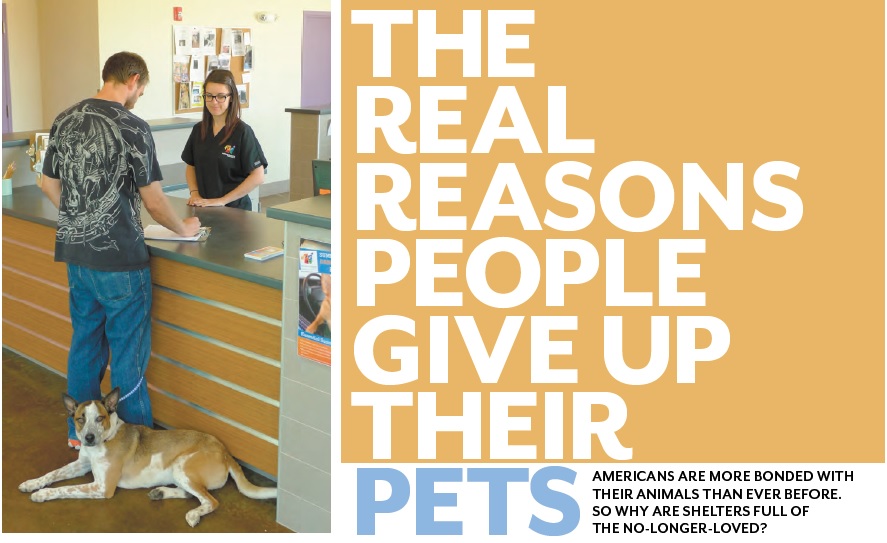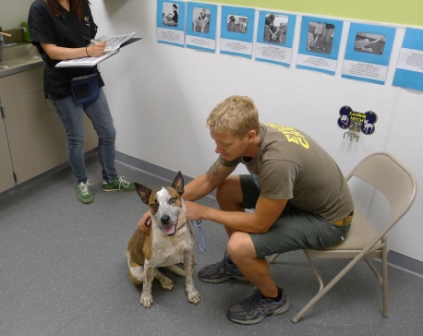MOST OF US GREW UP with an image of the classic American family that included Mom, Dad, kids, and Spot. Even back in the 1960s and ’70s, the dog or cat was part of the family. Today that’s truer than ever— Americans have never had so many pets, or loved them so fiercely. So why are shelters overrun with unwanted animals?
Sure, some people don’t spay or neuter, so you get unexpected litters. And surprisingly, there are no more animals coming into shelters than in the 1960s, according to the ASPCA, even though the pet population has climbed exponentially since then—and far more of them are getting out alive. But that still leaves more than 3,000 animals a year being euthanized in Albuquerque’s shelters, for example. So what goes wrong? How could a family member be dropped off in a place where it has a good chance of being killed?
Intense investigation into this question by shelters, rescue groups, and national organizations has begun to yield some interesting answers. The No. 1 reason people give for surrendering their animal, whether at a municipal shelter or nonprofit rescue like Animal Humane New Mexico, is that they’re moving and can’t take their pet. “Or they don’t want to travel with an animal—but how hard is it to travel with a cat?” Barbara Bruin, director of Albuquerque Animal Welfare, says incredulously.
In some cases this is justifiable, since apartment complexes and landlords often ban certain types or sizes of dogs, and people don’t always have the resources to look for other options. And homeless shelters almost never take pets, so during the recession people who lost their homes were forced to try living with their animals in their cars. No surprise that the second most common reason for giving up a pet is economic, especially when it involves vet bills for a sick, old, or injured animal.
But these two reasons serve more as catch-all justifications, animal workers say, for any number of ulterior reasons a pet is being relinquished. Crises happen, of course. But surrendering a pet in response to one is clearly more of a first resort than the last, given that hardly anyone (in America, at least) responds to crises by giving up their children.
The reality behind these rationalizations is becoming clearer now that shelters are making it harder to just hand in your pet. Both Albuquerque Animal Welfare and Animal Humane have started asking people to wait, either by getting on a waiting list or making an appointment in advance, which delays the surrender anywhere from two days to two weeks.
According
to Julie Buckland, program manager at the Albuquerque shelters, about
30 to 40 percent of people end up finding their own solution by the time
she calls them back. They have found an adopter on their own, or
decided to keep the pet. “Some people are just fed up that day, and two
days later they’re like, ‘He’s actually been a really good boy...,’” she
says. Animal Humane reports the same thing, as does the Santa Fe Animal
Shelter and Humane Society. “A lot of people are impulsive,” says Sam
Blankenship, director of adoptions at Animal Humane—so making them wait
has an impact. That’s why so many shelters nationwide are establishing
waiting lists and appointments (“managed admissions”) to slow the flow
of animal intake. “We want them to start viewing us as a last resort,”
says Buckland.
Shelters are also taking preventive measures to keep animals in their
homes, whether it’s giving away pet food or offering low-cost veterinary
care and temporary homes. Such measures are always cheaper than
sheltering animals, which is the most expensive option, says Karen
Medicus, head of community initiatives for the ASPCA.
Bernalillo County offers a good example of why. With no shelter of its
own, the county contracts with Albuquerque to take up to three animals a
day, paying for the service more than $800,000 per year. Animal Care
Director Matt Pepper says his department works hard to keep animals in
their homes, because he has to decide which three animals are going to
the shelter—to uncertain fates—every day.
In other words, when it comes right down to it, if you want to keep
your pet, or find the animal a good home, the rescue community stands
ready to help you keep that animal out of a shelter. People are often
motivated to work harder at solutions once they learn that euthanasia is
a possibility, according to shelter workers; many bring in their pet
only because they think it will be adopted. They may even try to gild
the animal’s resume by claiming a sudden allergy. “They don’t want to
say the dog isn’t housetrained, or the cat scratches,” Bruin notes. “I
would guess people don’t tell the truth because they don’t want to see
the pet euthanized.”
THE IRONY OF THIS situation is that “owner surrenders,” which make up
anywhere from 10 to 45 percent of the animals at New Mexico shelters,
are actually pet owners who care about their animal, and don’t want to
see it harmed.
“These are people who are doing exactly what we’ve asked them to do—
bring the pet to the place where they’ve been told is the safest place
for them,” says Emily Weiss, vice president of shelter research and
development at the ASPCA. “This is a person who loves their pet and
cares.”
Matt Pepper echoes her sentiment. “Sometimes we operate under assuming
the worst-case scenario—that anyone who surrenders their animal is a
bad person. But sometimes they are doing the right thing for the animal
because they can no longer provide the right level of care.”
Consider that almost all dogs in shelters once belonged to someone,
and that three-quarters of them come in to the Albuquerque shelters as
strays, and you see that the people who actually bring in animals
represent the responsible minority. A great many dogs are set loose,
dumped, not tracked down when they escape, or claimed to be stray by an
owner who doesn’t want to answer any questions. (Cats are a separate
issue, since so many of them are born feral.)
So why are people giving up a pet they care about, at the risk of
embarrassment, guilt, and condemnation? It’s actually a complex mix of
factors that ties in to the changing nature of the human-animal bond.
Although Americans have kept household pets since before World War II,
the nature of the relationship has evolved as the population has shifted
from rural to urban. The magnitude of pet ownership also has grown: As
people have moved to populated areas, pet ownership has hit an all-time
high of 68 percent of American households, and spending on them has
followed suit, topping $53 billion this year, according to the American
Pet Products Association (APPA).


